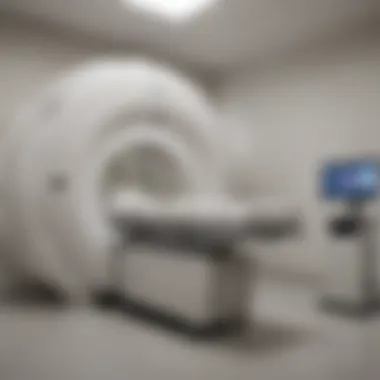Proton Therapy: Innovative Treatment for Prostate Cancer


Intro
Prostate cancer remains a significant health concern for men worldwide. Traditional treatment options, while effective to various degrees, often come with drawbacks. Proton therapy presents itself as an innovative and advanced approach in the fight against this form of cancer. This article will guide readers through the intricate aspects of proton therapy, examining its mechanisms, efficacies, and how it compares to more conventional therapies.
Understanding the specific dynamics that characterize prostate cancer is essential. The tumor's sensitivity to radiation and the challenges of sparing surrounding healthy tissues are central themes that proton therapy addresses effectively. This advanced treatment modality employs protons, which are positively charged particles, offering a focused delivery of radiation directly to the tumor site. The implications of this precision are profound, as they can potentially lead to better patient outcomes and reduce side effects.
This exploration will also delve into recent research trends, unpacking findings that underline the ongoing evolution of proton therapy in prostate cancer treatment. By synthesizing current knowledge, including advantages, costs, and long-term patient effects, the aim is to enrich the reader's comprehension of this sophisticated treatment path.
Preamble to Prostate Cancer
Understanding prostate cancer is essential, considering its high prevalence and significant impact on health. The prostate is a small gland that is part of the male reproductive system. It plays a key role in producing seminal fluid, which nourishes and transports sperm. However, when cancer forms in this gland, it can lead to various complications for men, especially in older populations.
Prostate cancer is the second most common cancer among men worldwide, making its study crucial. In many cases, it is slow-growing, but there are instances where it can be aggressive and spread to other parts of the body. By examining the prostate anatomy, the statistics surrounding the disease, along with the symptoms and diagnosis methods, we gain a clearer perspective on the challenges posed by prostate cancer.
Understanding Prostate Anatomy
The prostate is located just below the bladder and surrounds the urethra. Its functional role is vital during ejaculation. The size and shape of the prostate can change due to age or the presence of diseases, including benign conditions. Even a slight enlargement can lead to urinary difficulties. A thorough knowledge of prostate anatomy helps in understanding where cancers can develop and how they may affect overall health.
Prostate Cancer Statistics
Statistics reveal alarming trends in prostate cancer incidence. In the United States, for example, about 1 in 8 men will be diagnosed with this type of cancer during their lifetime. The American Cancer Society estimates over 200,000 new cases annually, indicating a persistent public health concern. This data reflects the importance of screening and early detection. It's also critical to understand survival rates, which can vary significantly based on numerous factors, including age and stage at diagnosis.
Symptoms and Diagnosis
Prostate cancer often does not show symptoms in its early stages. When symptoms do occur, they can include difficulty urinating, blood in urine, or painful urination. Such symptoms often lead to further investigation, typically starting with a digital rectal exam and a prostate-specific antigen (PSA) blood test. If these initial tests indicate the presence of cancer, more sophisticated imaging or biopsy procedures may be required.
Identifying prostate cancer in its early stages significantly improves treatment options and outcomes. Therefore, knowledge of prostate health and early diagnosis is central to effective cancer management.
Traditional Treatment Methods for Prostate Cancer
Understanding traditional treatment methods is essential to comprehending the advanced techniques that follow, particularly proton therapy. Prostate cancer, a condition that affects many men across the globe, has various established treatment approaches. Each method, though effective in its way, carries its own array of benefits, side effects, and considerations.
Radiation Therapy Overview
Radiation therapy is a cornerstone in the treatment of prostate cancer. It involves delivering high-energy rays to kill cancer cells or slow their growth. This method can be divided into external beam radiation and brachytherapy. External beam radiation targets the tumor from outside the body, while brachytherapy entails placing radioactive seeds directly into or near the tumor.
The primary advantages of radiation therapy include:
- Non-invasive treatment
- Minimal recovery time
- Preservation of surrounding healthy tissue depending on the method used
However, side effects such as fatigue, urinary issues, and in some cases, sexual dysfunction can arise. Success rates vary, but overall, radiation therapy remains a viable option for localized prostate cancer.
Surgery: Radical Prostatectomy
Radical prostatectomy is a surgical procedure that involves the removal of the entire prostate gland along with some surrounding tissues. This method is typically considered for patients with localized prostate cancer who are in good overall health.
The benefits of choosing surgery include:
- Potential for a complete cure if cancer is confined to the prostate
- Immediate resolution of cancer in the prostate area
Despite these advantages, surgery is associated with risks. Patients may experience complications such as bleeding, infection, and long-term effects like incontinence and erectile dysfunction. It is essential for patients to thoroughly discuss the risks and benefits with their healthcare providers prior to undergoing this procedure.
Hormonal Therapy
Hormonal therapy, also known as androgen deprivation therapy, is another approach for treating prostate cancer, especially in advanced cases. This method reduces the levels of male hormones, particularly testosterone, which can stimulate cancer growth.


The key points about hormonal therapy include:
- Slowing disease progression
- Reducing tumor size before surgery or radiation
Still, patients undergoing hormonal therapy might face side effects like hot flashes, weight gain, and reduced libido. Continuous monitoring is necessary to manage these effects efficiently.
Prostate cancer treatment is not one-size-fits-all, and understanding each method's nuances is critical for informed decision-making.
Prostate cancer treatment is not one-size-fits-all, and understanding each method's nuances is critical for informed decision-making.
In summary, traditional treatments for prostate cancer have demonstrated efficacy and are widely used. Each method possesses unique characteristics and outcomes. The choice of which method to employ often hinges on individual patient circumstances, including cancer stage and overall health.
Prelude to Proton Therapy
Proton therapy represents a significant advancement in the treatment of various cancers, particularly prostate cancer. This emerging modality utilizes high-energy protons to target tumors with precision. The importance of understanding proton therapy lies in its ability to minimize damage to surrounding healthy tissues, a key advantage over traditional radiation methods. This section outlines essential elements related to proton therapy, such as its definition, mechanisms, and comparative advantages over conventional approaches.
What is Proton Therapy?
Proton therapy is a form of radiation treatment that employs protons instead of standard X-rays to treat cancer. Protons are positively charged particles that can be controlled precisely, allowing for targeted delivery of radiation to tumors. When protons reach the tumor, they release their energy directly at that point, known as the Bragg peak.
This delivery method ensures minimal exposure of surrounding healthy tissue to radiation. For prostate cancer patients, this is particularly important. The prostate is located near critical organs and structures, such as the bladder and rectum, where damage can lead to significant complications. Proton therapy aims to improve treatment outcomes while reducing side effects that can negatively impact quality of life.
Mechanisms of Proton Therapy
The mechanisms of proton therapy involve the basic principles of physics and biology. To begin, the protons are produced in a particle accelerator, which propels them at high energy. When protons collide with the cancer cells, they create ionization. This ionization damages the DNA of the cancer cells, hindering their ability to reproduce.
The limited lateral spread of proton beams means that they can be focused on the tumor precisely. The treatment is delivered in multiple sessions, depending on the tumor's size and location. Each session is planned carefully to optimize the dose of radiation while protecting surrounding healthy tissue.
Comparative Advantages over Conventional Radiation Therapy
Proton therapy offers several advantages when compared to conventional radiation therapy techniques, such as photon therapy. Some of the main advantages include:
- Targeted Delivery: Proton therapy can target tumors with high precision, reducing radiation exposure to nearby healthy tissues.
- Reduced Side Effects: Patients experience fewer side effects, like bowel toxicity and urinary complications, as the surrounding organs receive less radiation.
- Dose Escalation: Higher doses of radiation can be delivered to the tumor while minimizing damage to surrounding healthy tissue.
"The ability of proton therapy to focus on tumors while sparing vital organs makes it a crucial option for prostate cancer treatment."
"The ability of proton therapy to focus on tumors while sparing vital organs makes it a crucial option for prostate cancer treatment."
Protocols for Proton Therapy in Prostate Cancer Treatment
Proton therapy has emerged as a precise method for treating prostate cancer. Understanding the protocols involved in proton therapy is essential for medical professionals and patients alike. These protocols ensure that the treatment is tailored to the individual needs of patients, maximizing efficacy while minimizing side effects. The treatment protocols generally encompass the treatment planning process and the specifics related to session frequency and duration.
Treatment Planning Process
The treatment planning process for proton therapy is intricate and involves multiple steps that define how the therapy is administered. Initially, imaging studies such as MRI or CT scans are conducted to accurately locate the tumor within the prostate. This imaging is crucial as it allows for enhanced precision in targeting the cancer cells while sparing surrounding healthy tissue.
Once the imaging is complete, a treatment team, which typically includes radiation oncologists, medical physicists, and dosimetrists, collaborates to develop a treatment plan. This plan details the exact dosage and angles for proton beams. Dosimetry plays a significant role, as it calculates the optimal amount of radiation to deliver, conforming closely to the shape of the tumor. The use of advanced software makes it possible to visualize and adjust the treatment plan as needed.
Additionally, patient positioning is considered critical. The team may use immobilization devices to ensure that patients remain in the same position during each treatment session. This consistency is vital for the effectiveness of proton therapy, as even minor shifts can alter the treatment's impact.
Session Frequency and Duration
The frequency and duration of proton therapy sessions can vary based on individual treatment plans. Typically, patients undergo therapy five times a week for several weeks. The total number of sessions can range from 20 to 40, depending on the specific case and cancer stage.
Each session usually lasts from 30 to 60 minutes, but the actual delivery of the proton beam takes only a few minutes. The remaining time is consumed in preparation and positioning of the patient. During each visit, the patient is closely monitored to assess any side effects, ensuring their comfort and safety throughout the treatment course.


Daily check-ins help in addressing any immediate needs and adjusting the treatment as necessary. Attention to detail during each session ensures optimal outcomes for the patient.
Daily check-ins help in addressing any immediate needs and adjusting the treatment as necessary. Attention to detail during each session ensures optimal outcomes for the patient.
Clinical Outcomes and Efficacy
Understanding clinical outcomes and efficacy is critical when evaluating proton therapy as a treatment for prostate cancer. Patients and healthcare providers need to assess not only the effectiveness of this innovative approach but also its implications for long-term health and well-being. The focus here centers on two main aspects: survival rates and quality of life after treatment.
Survival Rates
Proton therapy has demonstrated promising survival rates when used to treat prostate cancer. Several studies indicate that patients receiving proton therapy have comparable, if not improved, five and ten-year survival rates compared to traditional radiation methods. In particular, a prospective evaluation published in the Journal of Clinical Oncology revealed that 90% of men treated with proton therapy remain free from clinically significant cancer recurrence after five years.
Key factors influencing these rates include:
- Tumor Characteristics: The aggressiveness of the cancer, as well as its stage at diagnosis, greatly affects survival outcomes.
- Patient Age: Younger patients tend to have better outcomes due in part to their overall health and ability to recover.
- Treatment Precision: Proton therapy's precision in targeting tumors reduces damage to surrounding healthy tissues, leading to less complications and, ultimately, better survival.
The personalized nature of treatment planning plays a significant role in achieving favorable survival rates. Customized dosages and delivery methods can enhance the effectiveness of proton therapy, aligning with specific patient needs. This individualized approach contributes to the successful management of prostate cancer under various clinical circumstances.
"Survival rates in cancer treatment are influenced by a multitude of factors, including treatment fidelity and patient selection. Proton therapy offers a tailored solution that aligns with these needs."
"Survival rates in cancer treatment are influenced by a multitude of factors, including treatment fidelity and patient selection. Proton therapy offers a tailored solution that aligns with these needs."
Quality of Life Post-Treatment
Quality of life after therapy is paramount for patients. Proton therapy has shown advantages in preserving quality of life compared to conventional radiation treatments. Patients often report lesser side effects such as decreased rates of urinary incontinence and sexual dysfunction, which are common concerns following prostate cancer treatment.
Several studies highlight this favorable quality of life outcome:
- Reduced Side Effects: Patients experience fewer gastrointestinal or urinary complications, leading to better functional status.
- Psychosocial Well-being: Higher quality of life scores are often associated with reduced anxiety and mental health issues post-treatment, making recovery more manageable both physically and psychologically.
- Long-Term Satisfaction: Many patients express satisfaction with their post-treatment lifestyle, indicating that they can resume regular activities sooner than with other treatments.
In summary, proton therapy not only aims for survival but also emphasizes maintaining a higher quality of life for its recipients. This dual benefit provides a well-rounded perspective on the effectiveness of proton therapy in managing prostate cancer.
Side Effects and Risk Management
Understanding the side effects and risk management methods related to proton therapy is crucial for patients undergoing treatment for prostate cancer. Proton therapy, while offering significant advantages over conventional therapies, is not without its own set of potential side effects. By addressing these issues, both healthcare providers and patients can make informed decisions and implement strategies to mitigate risks.
Common Side Effects of Proton Therapy
Common side effects of proton therapy typically arise due to its specific mechanisms, focusing on the prostate region. Side effects can vary in intensity and duration, and it is important for patients to be aware of what to expect.
- Fatigue: A frequent complaint among patients undergoing any form of cancer treatment, fatigue may be exacerbated due to the body’s healing process.
- Skin Irritation: Patients often experience localized skin changes, including redness or a rash, in areas where the proton beams are directed.
- Urinary Issues: Symptoms such as frequent urination, urgency, or discomfort can occur. These issues are often related to the proximity of the treatment area to the bladder.
- Bowel Symptoms: Some patients may face gastrointestinal challenges, such as diarrhea or discomfort, though these are generally less common with proton therapy compared to traditional radiation.
"Awareness of potential side effects enables patients to address concerns before they begin treatment, promoting better overall management of care."
"Awareness of potential side effects enables patients to address concerns before they begin treatment, promoting better overall management of care."
Patients should keep open lines of communication with their healthcare team to discuss any developing side effects. Early intervention can often help to ease the impact of these reactions.
Managing Long-Term Risks
Long-term risks associated with proton therapy warrant careful consideration. While proton therapy is designed to minimize collateral damage to healthy tissues, ongoing monitoring is essential as some risks may not manifest until months or even years after treatment.
- Regular Follow-Ups: Patients should schedule continuous follow-up appointments post-treatment. This allows healthcare providers to monitor for late-onset side effects and assess overall health status.
- Holistic Care Approach: Implementing a comprehensive care strategy can enhance recovery. This may include nutrition counseling, psychological support, and physical therapy as needed.
- Educating Patients: Providing patients with knowledge on what symptoms to monitor can empower them to seek prompt medical advice if needed.
- Research Participation: Patients may consider participating in studies to contribute to the understanding of long-term impacts, benefiting not only themselves but future patients as well.
With these strategies in place, the focus shifts from merely experiencing side effects to effectively managing and mitigating them. Addressing these concerns ultimately enhances the overall patient experience and quality of life during and after treatment.


Cost Considerations
Understanding the financial aspect of proton therapy is crucial for patients and decision-makers. As the medical landscape evolves, the cost of treatments often influences patient choices. In the context of prostate cancer treatment, proton therapy presents both advantages and challenges related to its cost structure. This section delineates the various elements that contribute to the cost of proton therapy, how it compares to traditional methods, and the implications of insurance coverage on access to treatment.
Cost Comparison with Other Treatments
The cost of proton therapy frequently becomes a point of discussion among patients considering prostate cancer treatment. Here, it is essential to compare the overall expenses associated with proton therapy to those of conventional therapies such as surgery and standard radiation.
- Initial Treatment Costs: Proton therapy often requires sophisticated machinery and specialized facilities. The initial cost can be significantly higher than conventional external beam radiation therapy. Estimates indicate that treatment costs for proton therapy can range from $30,000 to $120,000, depending on the facility and treatment duration.
- Long-Term Considerations: While the upfront cost of proton therapy may appear daunting, it is critical to consider the potential long-term benefits, such as reduced side effects. Conventional therapies can lead to complications that might necessitate additional treatments, potentially increasing the overall cost for patients.
- Value-Based Assessment: Many health economists advocate for a value-based approach when evaluating costs. This means considering the cost against benefits such as improved quality of life and survival rates. Proton therapy often shows superior outcomes with fewer side effects, which may justify its higher costs in certain cases.
Thus, while the immediate price of proton therapy can be high, a nuanced evaluation reveals potential long-term savings due to fewer complications and better patient health outcomes.
Insurance Coverage for Proton Therapy
The discussion surrounding insurance coverage is complex and varies widely by insurer. Understanding the policies regarding proton therapy is essential for patients navigating their treatment choices.
- Coverage Variability: Not all insurance providers cover proton therapy, and there can be significant differences in coverage plans. Comprehensive policies may cover the total cost, while others may require patients to pay out-of-pocket for portions of their treatment.
- Pre-Authorization Requirements: Many insurers require pre-authorization for proton therapy to justify its necessity based on established medical guidelines. This process can be daunting for patients and may result in delays in receiving treatment.
- Emerging Trends: As proton therapy gains more recognition in the medical community, particularly supported by positive clinical outcomes, some insurance policies are beginning to adapt. This shift may increase access to proton therapy for patients who previously faced barriers due to costs.
In summary, while proton therapy can be more expensive upfront, its overall economic implications depend on various factors including treatment outcomes and insurance coverage. Patients considering this treatment should engage in thorough discussions with their healthcare providers and insurance representatives to fully understand their financial commitments.
Future Directions in Proton Therapy Research
Proton therapy continues to capture the attention of researchers and clinicians in the oncology field, particularly concerning its application for prostate cancer treatment. This section explores emerging techniques and trends in clinical practice, emphasizing their potential to enhance treatment efficacy and patient outcomes. Recent advancements in technology and therapy protocols signify how this method can adapt to meet the dynamic needs of oncology.
Emerging Techniques
Research efforts are actively focused on refining proton therapy techniques to maximize its effectiveness. One significant advance is the development of pencil beam scanning, which allows for more precise targeting of tumors while minimizing radiation exposure to surrounding healthy tissues. This method also enables conformality, where the delivered dose closely matches the shape of the tumor.
Additionally, the integration of image-guided radiation therapy (IGRT) with proton therapy is gaining traction. By combining real-time imaging with treatment delivery, clinicians can adjust the aim of proton beams during sessions, accounting for any movement of the tumor or patient. This development not only enhances dose accuracy but also reduces the risk of complications.
Advancements in computational technologies, such as AI and machine learning, also show promise. These tools can analyze large datasets to identify optimal treatment plans tailored to individual patients, simplifying the decision-making process.
"The ongoing innovations in proton therapy suggest a future where treatment can be more precise and tailored to individual patient needs, potentially improving outcomes significantly."
"The ongoing innovations in proton therapy suggest a future where treatment can be more precise and tailored to individual patient needs, potentially improving outcomes significantly."
Trends in Clinical Practice
As proton therapy becomes more entrenched in clinical practice, several trends are emerging that reflect its evolving role in oncology. A notable trend is the establishment of multidisciplinary treatment approaches. Collaboration among urologists, radiation oncologists, and medical physicists is essential to create comprehensive treatment plans that incorporate proton therapy effectively.
Moreover, clinical trials are increasingly focused on comparing proton therapy with other treatment modalities. These trials aim to establish clearer guidelines on when proton therapy may be the superior choice, especially for patients with localized prostate cancer who might benefit from its targeted nature.
As healthcare continues to emphasize personalized medicine, proton therapy is likely to play a larger role in treatment strategies. Customizing therapy based on genetic and molecular tumor characteristics can enhance the therapeutic impact, moving away from one-size-fits-all approaches.
In summary, the future directions for proton therapy research hold great potential. With emerging techniques and evolving clinical practices, there is hope for improved outcomes in prostate cancer treatment, underscoring the necessity for ongoing investigation and adaptation in this field.
Epilogue
The discussion around proton therapy as a treatment for prostate cancer provides insightful information relevant for patients and medical professionals alike. As we summarize the significant aspects of this therapy, it is crucial to highlight the unique elements that set it apart from traditional approaches.
Summary of Key Findings
Proton therapy stands out due to its precise targeting of cancerous tissues. Unlike conventional radiation therapy, which can affect surrounding healthy tissues, proton therapy uses protons that deposit energy directly in the tumor. This characteristic minimizes damage to adjacent structures, such as the bladder and rectum. Furthermore, our investigation shows that many patients report lower incidences of side effects, particularly urinary and sexual dysfunction. Studies indicate that proton therapy can achieve survival rates comparable to those of standard radiation options while enhancing quality of life post-treatment.
- Precision targeting leads to fewer side effects.
- Improved quality of life for many patients compared to traditional methods.
- Comparable survival rates to conventional therapies.
These findings underscore the potential of proton therapy in improving treatment outcomes for prostate cancer patients.
Implications for Future Treatments
As we look to the future, proton therapy may influence the landscape of prostate cancer treatment significantly. Ongoing research and technological advancements are likely to enhance its application, making it more widely available. Insights gained from current studies can guide future clinical practice, advancing treatment protocols and patient selection criteria.
Additionally, raising awareness about proton therapy among healthcare professionals could lead to better integration of this treatment within multidisciplinary care teams. This expanded usage may prompt further investigation into the long-term benefits and effectiveness in diverse patient populations. Future innovations, including potential combination therapies involving proton therapy, could optimize patient outcomes.







